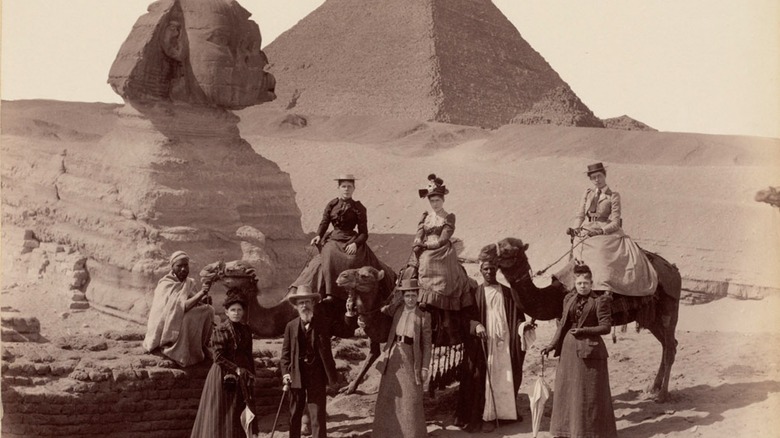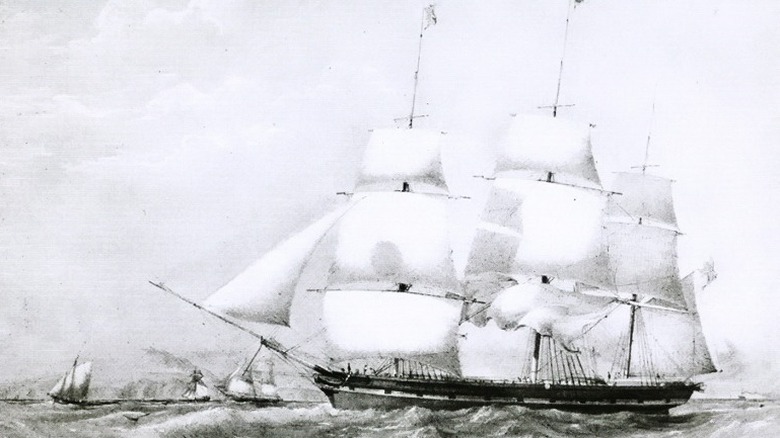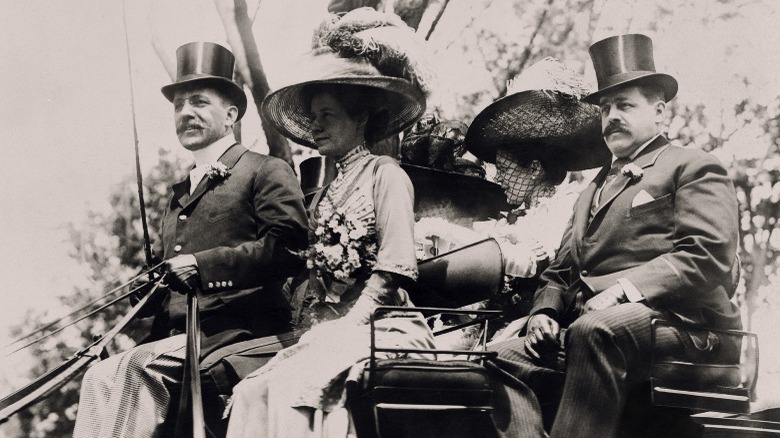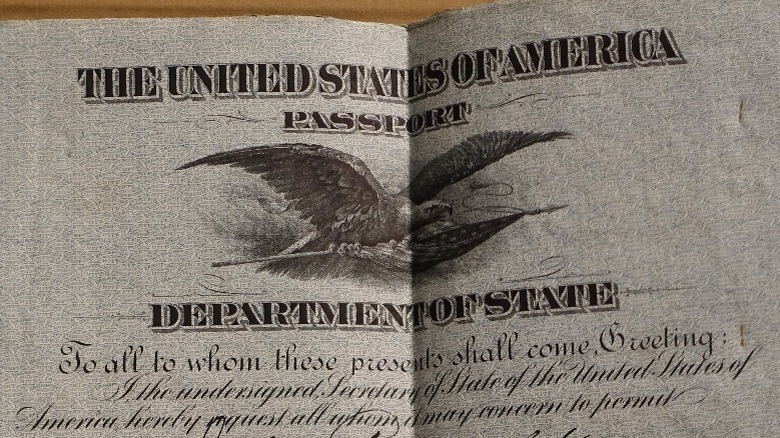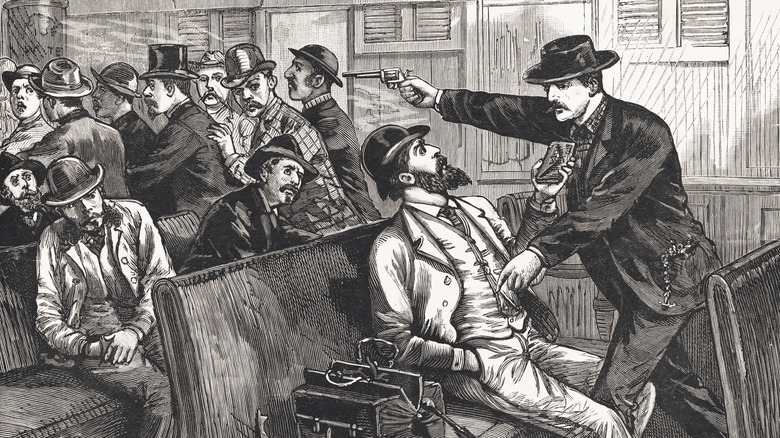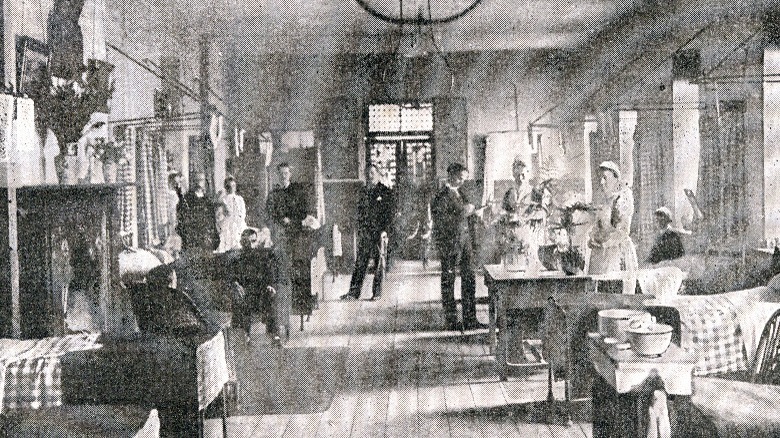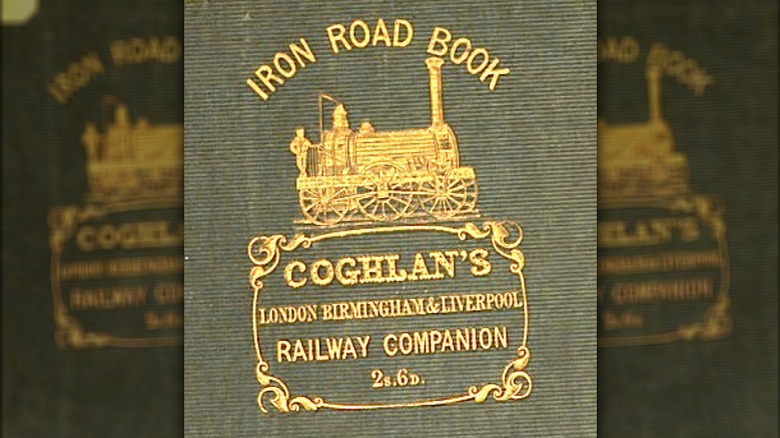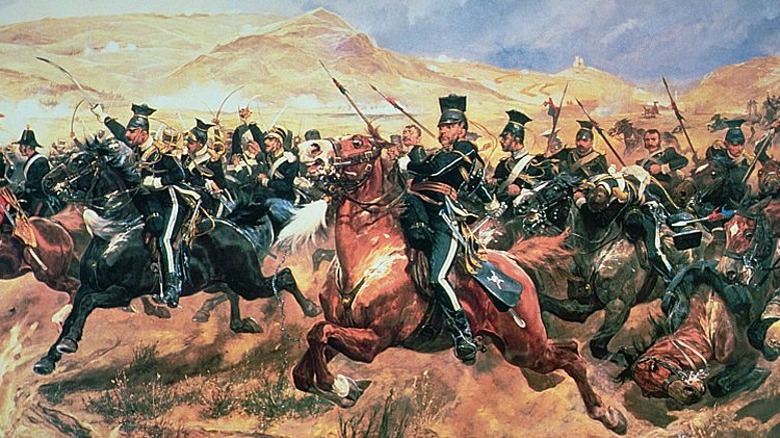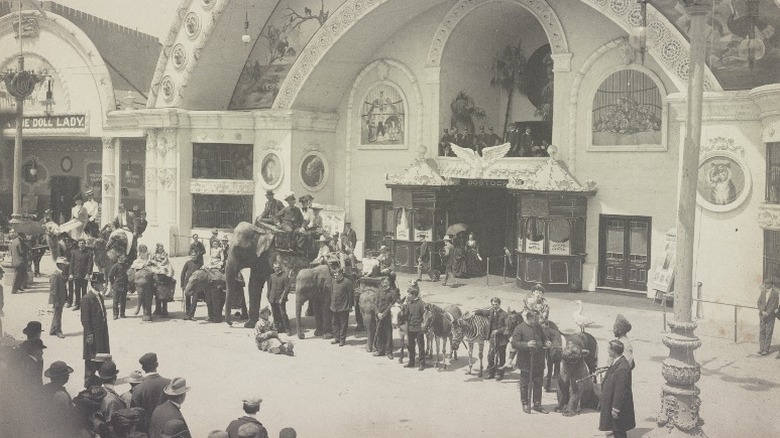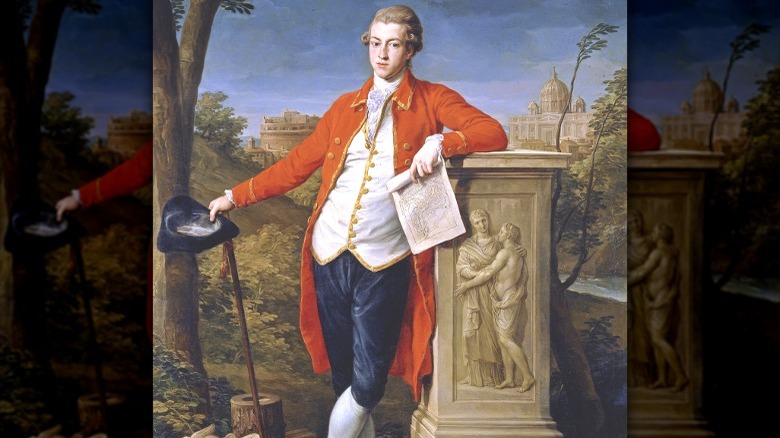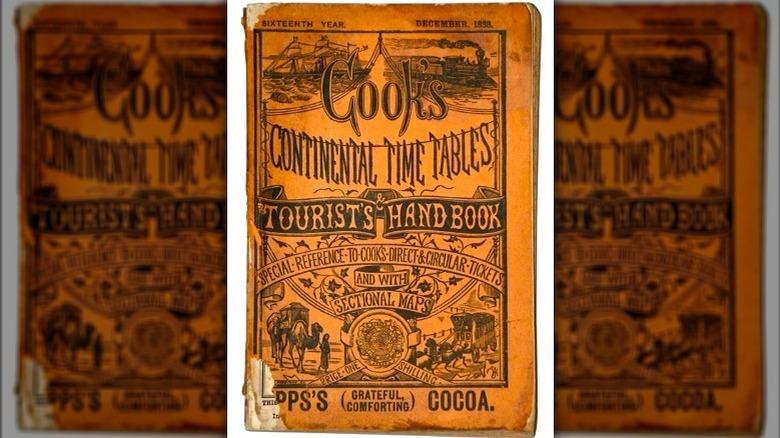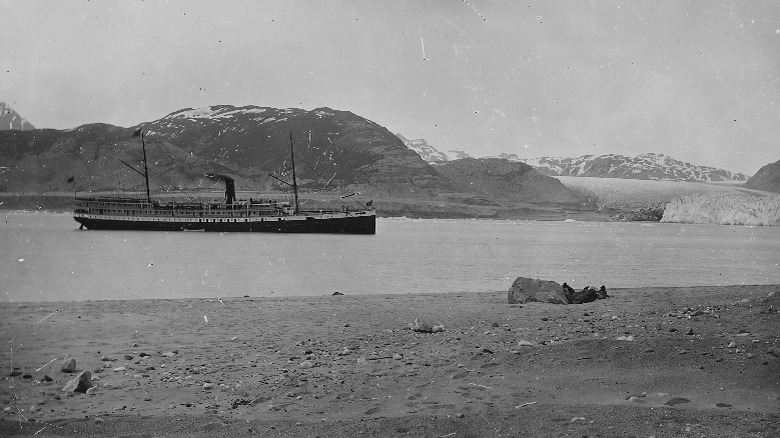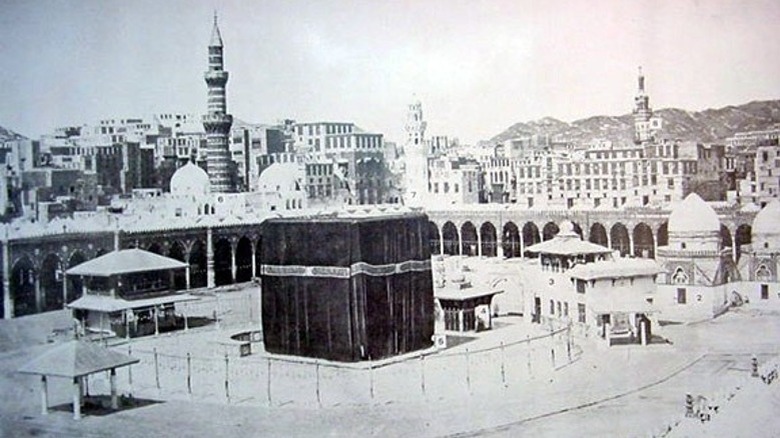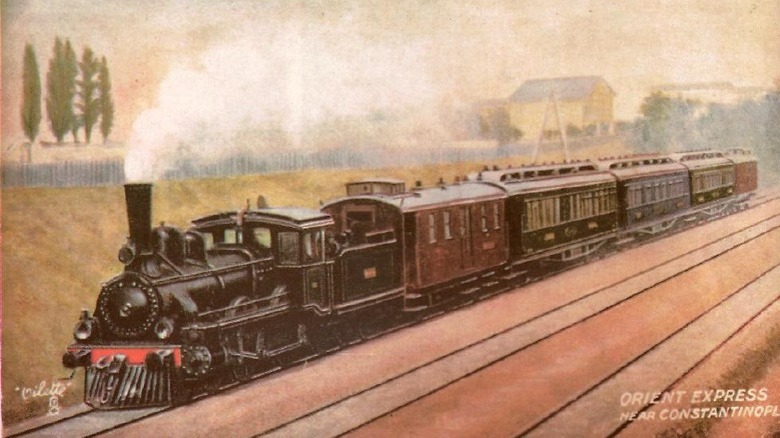What Traveling Abroad In The 19th Century Was Really Like
Compared with even 125 years ago, it's hard to imagine just how much travel abroad has changed. Airplanes have replaced ocean liners, travel has become much more affordable and safe, and the number of destinations around the globe catering to tourism has vastly increased. Trips that would have taken weeks or months by ship, can now be done in just a few hours via commercial jetliners. Even booking a vacation abroad is easier, as you only need a credit card, passport, and a smartphone, and you can find yourself almost anywhere on the globe in a matter of hours.
With luxury travel seemingly becoming standardized by today's standards, you better believe that things used to be much different back in the 19th century. Airplanes were far from being commercialized, requiring any travel over the ocean to be done by ship. This was both very time-consuming, which limited excursions abroad to only those who could afford to take a long vacation, and was also at times dangerous compared with modern travel.
Still, millions and millions of people made trips overseas and to foreign countries, for everything from business, to religion, to pleasure. From the dock to the destination, this is what traveling abroad in the 19th century was really like.
You had only one option for crossing the ocean
For those interested in crossing an ocean to experience what life was like on the other side, your options for traveling across were pretty limited. If you wanted to cross the Atlantic or the Pacific, you needed to travel by ship. Even that wasn't a reliable option for some years, as it was not until 1818 that the now famous Black Ball Line came into existence as the first regularly scheduled ocean liner.
It was not until the late-1830s that the first passenger steam liners became popular, and two companies dominated the 1840s: Great Western Railway from Britain and the Cunard Line from America. The Great Western Railway Company had two steamships, the Great Western and the Great Britain, but they were not the most reliable. In contrast, the Cunard Line had four ships and was much more successful in the '40s. The Cunard faced off against the Collins Line in the 1850s, but by the 1860s, Great Western was in front, and they would remain there through the rest of the century.
By the last decades of the 19th century, luxury liners began to make their first appearances, making ocean travel elegant and classy. Chances are, if you wanted to cross the Atlantic in the 1800s, you probably rode on the Black Ball Line, Cunard Line, Collins Line, or Great Western Railway Line. These were primitive ships compared with today, but they were the only way to get across.
The middle class traveled, too
It might sound surprising, but travel abroad in the 19th century was actually pretty widespread and more affordable than you might think. Far from only being reserved for the richest and wealthiest members of society, according to the National Archives and Records Administration, more than half a million Americans had passports issued to them from 1810–1909. That doesn't even include the potentially thousands more passports that were issued by states prior to 1856. Passport holders from many walks of life, including people traveling for business, religion, visiting family members or friends, or just for pleasure.
Many middle-class households made the trip to foreign lands, and men were responsible for most of the overseas travel, but many were also accompanied by women, too. In addition, many ocean liners offered cheap fares in "Third Class," which was uncomfortable, but allowed the possibility to travel to new lands affordably. It was towards the end of the 19th century that the first cruise ships came into existence, and these were largely marketed to the wealthy and elite.
Passports were optional
For people frequently traveling abroad today, one of their most prized and treasured possessions is undoubtedly their passport. Without your passport, it's nearly impossible to leave the country through an airport or on a commercial ship, and getting back home is even more tricky. By now, it's pretty much hardwired into most people that if you are even considering international travel, you need to get working on getting your passport up to date immediately.
Yet, in the 19th century, passports were essentially optional for most Americans. Even though the State Department issued more than half a million passports from 1810–1909, the only time they were actually required for travel was for a brief period immediately following the outbreak of the Civil War in 1861 (per the National Archives and Records Administration). Prior to 1856, individual states and judicial authorities were allowed to issue their own passports, but they were not legally required for entry into any U.S. port.
Another big difference between passports of today and passports of the 19th century is that back then the government issued them to groups rather than individuals. One male from the group would apply, and his application would provide information for all potential travelers joining him. It would not be until well into the 20th century that passports would become required for passage abroad, and by then travel was drastically different.
It could be dangerous
Even when traveling today, one of the most important things that people need to be wary of is their safety abroad. The last thing anyone wants is to have a disaster or fall victim to a crime when traveling, but unfortunately, in the 19th century, that could happen more than you think. Even the journey across the ocean was risky in and of itself. Compared with today, the ocean liners of the 19th century were nowhere near as reliable, and traveling on the open ocean could be harrowing.
This was before the days of radio communication and GPS, so if your ship or convoy got into trouble in the middle of the ocean, you had few prospects to signal for help or for survival. In addition, once you arrived in the country, you still had to be wary of unscrupulous locals looking to take advantage. According to the Baltic Journal of Health and Physical Activity, one of the most notoriously dangerous places for tourists was 1820s Italy. Bandits would rob tourists throughout the country, especially in rural areas.
Spain wasn't much better in the 1840s, with robbers extorting money through impromptu tolls and thieving. Even travel to the United States wasn't always safe, as train robbers made travel on the railways a dangerous excursion at times. Travel abroad could be great in the 1800s, but you also had to keep your guard up.
Some traveled for health
Back in the 19th century, people traveled abroad for a litany of reasons. Some were emigrating away to a new country, others were visiting their homelands, and many traveled for business or to see acquaintances for the first time in decades. One of the most popular reasons to travel was also to improve one's health. Similar to people traveling to foreign countries now for either superior or cheaper medical services, many 19th-century tourists also had their eyes on bettering their health.
Throughout Europe (and Oceania), many places dubiously advertised themselves as providing medical cures to those with illnesses (via the Royal College of Physicians). These ranged from gout to arthritis to just about anything you could be ailing from. Health resorts sprung up around the world catering to health tourists on vacation. Many places created pamphlets that they distributed to boast about the benefits of their resorts.
Even royalty bought into the hype, and King Edward VII was known for traveling abroad to help with his illnesses. Some people also wrote guides to various health resorts, letting readers know where to go for which ailments. With the state of medical knowledge back then, it was unlikely most of these health resorts provided much of anything besides relaxation and good service, but that didn't stop untold amounts of tourists from trying them out.
Coghlan's Guides
Though a staple of modern travel, even back in the 19th century people still relied on traveler's guides to help them navigate around while abroad. While today, people often look to sources like Lonely Planet or Frommers, those weren't options back then. However, people did have access to some reputable guides, most notably that of Francis Coghlan. "Coghlan's Guides for Travelers," as they were called, provided travel information for many areas throughout the world, primarily Europe. Tourists could pick up a copy of Coghlan's guides and get tons of valuable information about their new destination.
Coghlan supplied travelers with information on Italy, Germany, Paris, England, and many other countries. He published his guides during the mid-19th century, and they were read by countless individuals. According to an 1840 register from the Netherlands (via Google Books), Coghlan also wrote maps as well as translations between German, French, and English, and already had 14 years of experience by then. Some of Coghlan's guides were illustrated, and they provided information on local areas that would be helpful for tourists, such as providing a French guide "explaining every form and expense from London to Paris."
Beware of war
Traveling overseas could definitely be an adventure in the 19th century, but you certainly had to be careful. Not only did you have to be wary of thieves and bandits in some places, but the threat of war was very real in many areas throughout the century. What's more, word traveled back then, but not nearly as fast as it does today, and travel also took an exceptional amount of time. That meant that you could take off when everything was hunky-dory, only to land in a foreign country in a state of war.
Travelers to America in the early-1860s had to be mindful of the ongoing Civil War, which probably discouraged more than just a few people from visiting. In the early years of the century, parts of Europe were raging with the Napoleonic Wars, which surely caused a drop in tourist enthusiasm for many potential visitors. In the 1820s, anyone looking to visit the ruins of Ancient Greece first had to think twice about walking into a potential battlefield of the Greek Revolution.
It's also likely riders of the Orient Express in the 1850s probably found the Ottoman Empire a bit less hospitable due to its fight with the Russians during the Crimean War. These are just a few of the battles people had to be cautious of, and there were countless more. War is never fun, and it's the last place you'd want to find yourself while on vacation.
The World's Fairs
The World's Fairs are largely out of fashion now, but during the second half of the 19th century, they were all the rage. The fairs took place throughout the world, including in England, Australia, Tasmania, Guatemala, the United States, and other places. The fairs greatly promoted international travel, as people wanted to see what unique advances in science and technology each country could offer.
One of the first big world's fairs was Britain's Great Fair of 1851, and it attracted more than 6 million visitors from around the world. The fairs only became more popular as the century wore on, and more than 10 million people came to the Centennial Exhibition held in Philadelphia, Pennsylvania in 1876. Booths at the Centennial Exhibition ranged from steam engines to mechanical calculators to art to much more.
Other important World's Fairs were the International Exposition of 1889, which saw Paris unveil the Eiffel Tower, and the 1893 World's Columbian Exposition which was held in Chicago, Illinois. Not all of the fairs made money, but the new audiences they brought were enough to keep them going year after year. Tourists kept visiting the World's Fairs well into the 20th century, and they still occur periodically today.
The Grand Tour
For the wealthy young men of Europe in the 19th century, one of the more insightful journeys they could take was known as the Grand Tour. It dates back to the 17th century and was still in vogue by the 1800s. The Grand Tour was not a formal expedition with a specific set of regulations and destinations but was an informal tour of Europe meant to broaden one's horizons through art, politics, and culture.
Most Grand Tourers would start out in Britain, and make their way to Paris as the first stop. The first legs of the tour usually consisted of France and Italy, and later would also include the island of Sicily as well as Greece. Travel was not always easy or cheap, and this wasn't exactly a weekend trip, with some tours taking almost a decade. Railways came into vogue midway through the century, as most tourers rode on horseback and carriage for their journeys before then.
The Grand Tour was essentially reserved only for the truly wealthy and elite, and it was seen as very beneficial in creating a man of class who was knowledgeable about world affairs. Tutors helped guide many young men on their tours, and it wasn't until travel became more affordable that the Grand Tour as an aristocratic trip died out.
Thomas Cook & Son
Not only could people look at travel guides when they wanted help navigating their journeys abroad in the 19th century, but back then they even had a travel agency, too. The Thomas Cook and Son travel agency first opened their doors in the 19th century, after founder Thomas Cook began leading people on excursions throughout England in the 1840s. In the 1850s, Cook started to expand from just England into other countries in Europe, and the first international travel agency was born.
Cook opened a storefront in 1865, and the following year — after the Civil War had ended — Cook traveled to America on his company's inaugural tour across the Atlantic. Later, Cook would take people to Egypt and Palestine in the Middle East, and even distributed an early form of traveler's checks to his customers. Just prior to Cook's death, his son John Mason Cook took over the company, and it continued to grow throughout the century and into the 1900s.
Incredibly, Thomas Cook and Son managed to make it through the new millennium, finally ceasing operations in 2019 after more than 175 years in the business. Thomas Cook and Son wasn't an option for most people traveling in the 1800s, but for those who were lucky enough to afford it, it was surely a once in a lifetime experience.
Cruise to Alaska, anyone?
As incredible as it sounds, starting in the late-19th century, cruises to Alaska became available. According to the Alaska Journal of Commerce, beginning in 1875, the Oregon Steamship Company started offering cruise service to Alaska, but they soon found themselves with stiff competition. Hailing from San Francisco, the Pacific Coast Steamship Company moved in on Oregon's turf in 1881. At first, taking an Alaskan cruise was only for the wealthy, and Pacific Coast specifically marketed their tours to "pleasure travelers." However, soon economy fairs became available, and tourism greatly increased.
Amazingly, cannons were used to announce the ship's arrival at port, and tourists found themselves looking at miles and miles of untouched wilderness. Within a few years, thousands were taking the Pacific Coast line annually at the cost of $15–$30. In the 1890s, Pacific Coast created a ship with a capacity of 250 rooms, but they began to face more competition as more companies entered the fray.
Passengers on the ship were occasionally witness to pretty interesting events, like when one of the ships was found to be smuggling illicit opium. By the mid-1890s, tourists were flocking to Alaska in even bigger numbers, but not so much on pleasure cruises. The Klondike Gold Rush brought thousands of new visitors to Alaska, relegating pleasure tourism to second place. Alaskan cruise lines quickly recovered, and even today are some of the most popular destinations available.
Religious travel to the Middle East
Many people chose to travel in the 19th century for business and pleasure, but one of the biggest drivers of international tourism was also religion. Partly due to Thomas Cook and his new travel agency, many Christians began traveling to the Middle East to visit areas like Egypt and Palestine (via the University of York). Cook's agency took thousands, and people found other means to get there, too. Even royalty found themselves visiting the area to tour.
In addition to Cook's tours and Christian pilgrimage to the Middle East, Muslims continued to make the annual Hajj to Mecca every year of the 19th century. The Hajj is a religious pilgrimage to Mecca, Saudi Arabia, that Muslims are to undertake every year if they are able. The Hajj began hundreds of years prior to the 1800s, and by then was already consisting of huge amounts of followers. According to Ohio State University, sometimes Ottoman Empire bands of up to 50,000 pilgrims traveled together on the Hajj to Mecca in the 1800s.
Though at times European rulers who controlled territory along ancient Hajj viewed the pilgrimage as dangerous due to its potential to spread diseases like cholera, they also saw its utility and eventually began to embrace it. Some governments even helped subsidize the Hajj for some pilgrims. By the end of the 19th century, the Hajj was only more popular, and it continues through today.
The Orient Express
For nearly a century, one of the most famous rail lines in the entire world was the now-legendary Orient Express. The Express was a luxury train that first began service in 1883. It was created by Georges Nagelmackers, a Belgian with an eye for the future. The train began service in Paris, France, and traveled the length of continental Europe, reaching all the way to what was then Constantinople in the Ottoman Empire (modern Istanbul, Turkey).
The Orient Express defined luxury at the time, and passengers on board were in for some pretty nice treats, including exquisitely decorated interiors and excellent food. The trip took more than three days to accomplish and was not just used by commoners. Even kings, czars, and presidents rode on the Orient express during its heyday in the 19th century. In addition, secret agents also apparently used the express as a way to gather information and for convenient travel. The express lasted into the 20th century, finally closing its doors in 1977.
